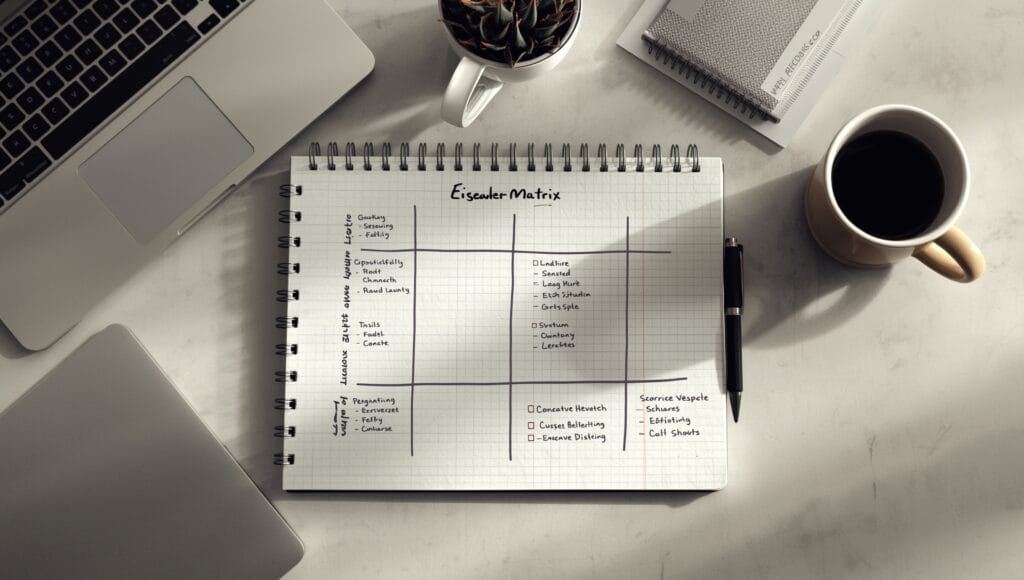Feeling overwhelmed by your endless to-do list? You’re not alone. The real challenge isn’t doing the work; it’s knowing what to work on first. This is where learning how to use the Eisenhower Matrix changes the game. It’s a simple yet powerful task prioritization method that helps you cut through the noise. Ultimately, it allows you to focus on what truly moves the needle in your life and work. Best of all, we’ve included a free template to get you started immediately.
What Exactly Is the Eisenhower Matrix?
First, let’s break it down. The Eisenhower Matrix, also known as the Eisenhower Box or Urgent-Important Matrix, is a decision-making tool. It was popularized by the 34th U.S. President, Dwight D. Eisenhower. Famously, he said, “What is important is seldom urgent, and what is urgent is seldom important.”
This quote forms the core principle behind the matrix. Essentially, it forces you to categorize every task based on two criteria:
- Urgency: Does it require immediate attention? Tasks that have immediate deadlines or negative outcomes if delayed are considered urgent.
- Importance: Does it contribute to your long-term goals, values, and mission? Important tasks have a significant impact.
By plotting tasks on a grid with these two axes, you create four distinct quadrants. Each quadrant tells you exactly what to do with the tasks inside it.see our guide on time management strategies.
The Four Quadrants of the Eisenhower Box Explained
Understanding the four quadrants is the core of knowing how to use the Eisenhower Matrix effectively. Let’s dive into each one.
1 Quadrant : Urgent and Important (The “Do” Quadrant)
- What it is: These are crises, pressing problems, and tasks with tight deadlines. They demand your immediate attention.
- Examples: A server outage at work, a last-minute project from your boss, a crying child who fell and scraped their knee.
- Action: DO these tasks immediately.
- Pro Tip: If you constantly live in Quadrant 1, you’re in a reactive, stressful state of fire-fighting. The goal is to minimize tasks here by spending more time in Quadrant 2.for long-term productivity (learn self-discipline).
Quadrant 2: Important but Not Urgent (The “Planning” Quadrant)
- What it is: This represents the prime area for peak productivity. These activities are crucial for achieving your goals but don’t have the pressure of a deadline. They require proactive effort.
- Examples: Strategic planning, exercise, learning a new skill, building relationships, and preventive maintenance.
- Action: SCHEDULE time to focus on these tasks. This is where real progress happens.
- Pro Tip: High-performers spend most of their time in Quadrant 2. It’s the key to preventing future crises and creating the life you want.
3 Quadrant : Urgent but Not Important (The “Delegate” Quadrant)
- What it is: These tasks are interruptions that feel urgent but don’t contribute to your own goals. They are often about other people’s priorities.
- Examples: Most emails, phone calls, unnecessary meetings, and colleagues asking for “quick favors.”
- Action: DELEGATE these tasks to someone else if possible. If you can’t delegate, minimize the time you spend on them.
- Pro Tip: This quadrant is a major source of distraction.The ability to say “no” or “not right now” is a powerful skill in this context.(stop procrastinating).
Quadrant 4: Low Priority: Neither Urgent nor Important (The “Eliminate” Quadrant)
- What it is: These are pure time-wasters. They offer no value and often serve as escapism.
- Examples: Mindlessly scrolling through social media, binge-watching TV, gossip, trivial busywork.
- Action: ELIMINATE these activities from your schedule. They are thieves of your time.
- Pro Tip: Be brutally honest when categorizing tasks here. We often fall into Q4 activities as a way to avoid the harder work in Q2.(morning routines for success)
Your Step-by-Step Guide: How to Use the Eisenhower Matrix Today
Now for the practical part. Here’s how you can implement this productivity tool right now.
Step 1: Brainstorm Your Task List
Take a sheet of paper or start a note on your device. Write down every single task, project, and obligation swirling in your head. Don’t filter anything at this stage.
Step 2: Download Your Free Template
To make this easy, we’ve created a simple free template for you. [Link to your template download]. It’s a printable PDF and a digital Excel sheet. Print it out or open it up.
Step 3: Categorize Every Task
This is the most crucial step. For each task on your list, ask yourself two questions:
- “Is this urgent?” (Does it need to be done today/now?)
- “Is this important?” (Does it align with my core goals?)
Using your responses, assign each task to its appropriate quadrant on the template.
Step 4: Take the Prescribed Action
- Q1 Tasks: Knock these out first. Your immediate goal is to clear this quadrant.
- Q2 Tasks: This is your focus. Open your calendar and actually block time for these items. Treat this time as a non-negotiable appointment.
- Q3 Tasks: Who can you ask for help? Can you outsource this? If it’s an email, can you reply with a brief “I’m not the right person for this, try X”?
- Q4 Tasks: Be ruthless. Cross them off your list completely. They don’t deserve your mental energy.
Step 5: Make It a Habit
The matrix isn’t a one-time fix. For best results, make it a ritual. Try doing this every Monday morning to plan your week or every evening to plan the next day.
Real-Life Example: Putting the Matrix to Work
Let’s make this concrete. Imagine two different scenarios:
Scenario A: A Project Manager’s Workday
- Q1 (Do): A critical bug is found in a live product.
- Q2 (Plan): Sketching out the architecture for the next quarter’s project.
- Q3 (Delegate): A request for data that an intern can pull.
- Q4 (Delete): Checking LinkedIn every 20 minutes.
Scenario B: A Busy Parent’s Weekend
- Q1 (Do): Your child has a fever and needs to see a doctor.
- Q2 (Plan): Meal prepping for the week to eat healthier.
- Q3 (Delegate): Can your partner or a grocery delivery service do the shopping?
- Q4 (Delete): Watching a TV show you don’t even enjoy.
See how the urgent vs. important lens applies to everything?
Actionable Tips to Master the Eisenhower Method
- Beware of the “Urgency Trap”: We are wired to respond to urgent stimuli. Often, we let a ringing phone (Q3) interrupt deep work (Q2). Turn off notifications to protect your Q2 time.(focus tips)
- Clarify Your Goals: If you don’t know what’s “important” to you, you’ll never be able to categorize tasks correctly. Spend time defining your long-term goals.
- It’s Okay to Be Wrong: Your first attempt at categorizing might be off. A task you thought was important (Q2) might actually be trivial (Q4). Review and adjust your choices.
- Use Technology: Apps like Todoist, Trello, and Notion have built-in ways to create your own Eisenhower Box using labels and boards.
Conclusion: Take Back Control of Your Time
Learning how to use the Eisenhower Matrix is more than a productivity hack; it’s a fundamental shift in how you view your time and priorities. It moves you from being reactive to being intentional. By consistently separating the urgent from the important, you stop letting your to-do list manage you and start managing it.
You’ll spend less time putting out fires and more time building something fireproof. So, what are you waiting for? Download your free template and in the next 15 minutes, you can clear your head and make a plan that actually works.
[Click Here to Download Your Free Eisenhower Matrix Template]
What’s one task you’re going to delegate or delete today? Share in the comments below!



